In this comprehensive post, we'll go over;
The most common causes of washing machine water damage how to prevent it.
You'll also learn;
- Situations to avoid.
- Solutions on how to fix washing machine issues.
- What to do if you already have washing machine water damage.
So if you've ever wondered why you seem to always have water under the washer, you'll love this post!
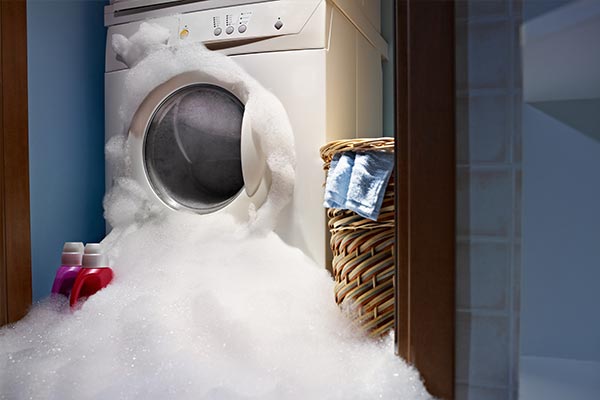
When any type of water damage occurs in a home or business, it can be devastating. The professionals at Rock Emergency in Rochester, NY understand and we are here to help you through the whole process.
From evaluations to working with your insurance company, we’re here for you. Washing machine water damage is among the most common sources of water damage in homes.
Did you know that one load of laundry uses around 30 gallons of water? That’s about the same amount of water it takes to fill a regular-sized bathtub.
Since it is so common, we have curated a list of common causes of washing machine leaks as well as solutions on how to prevent them.
Don’t worry, we also give you some advice on what to do if it has already happened.
Common Causes of Washing Machine Leaks
Wondering where the water is coming from? These common causes of washer leaks might give you your answer...
Hose Leaks
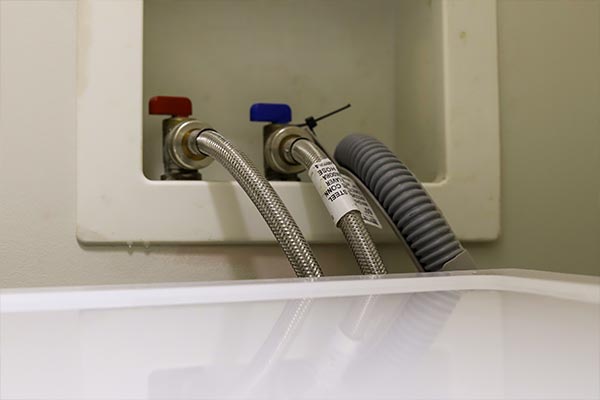
Most hoses are made of rubber and will get brittle as they get older causing them to crack or break. Additionally, if they are connected improperly it can also be the cause of leaks. Often these types of leaks will be constant, no matter the cycle.
A broken water supply hose can pour 650 gallons of water per hour into your home. There are 3 hoses connected to a washing machine. Hot and cold water supply hoses, and a drain hose.
Drainage Issues
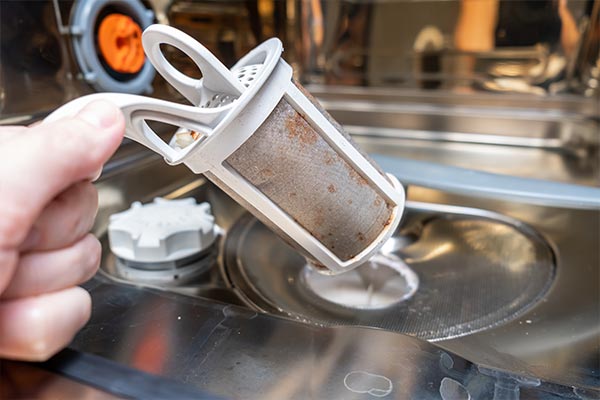
Clogs, backed-up sewers, improper alignment of drainage pipes can all cause leaks. This type of washing machine leak will often occur during a spin cycle, or when the washer has finished.
If you use a drainage basin or sink, there may be cracked or broken pipes to be on the lookout for as well as a cracked drainage basin.
Internal Leaks
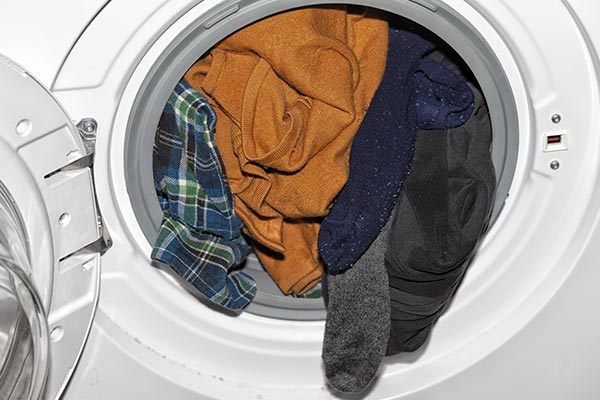
Consistent overload of the washer or the internal water pump is likely culprits. Internal leaks often occur during the wash cycle but before the spin cycle. An overloaded washer is the most common reason for a washing machine flood.
Also, too much detergent can cause excessive suds which can leak out of the machine causing flooding damage as well.
Solutions to Avoid Washing Machine Leaks
- You should replace hoses every 5 years, stainless steel braided hoses are more durable and last longer.
- Inspect hoses monthly, note signs of moisture or any possible defects
- Before using the washing machine after a storm, ensure there are no issues with the sewer line
- Don’t overload the machine
- Keep drain pipes clear, install a lint trap to help prevent clogging.
- Use the right detergent and the right amount. The manual should say how much to use.
- Run laundry when you are home, if anything happens you are there to possibly stop problems before they get out of control.
- Have a professional install new appliances to prevent drainage issues or pinched water lines
- If you see any leaks, shut off the intake valve behind the washer. If you can’t reach the valve, know where and how to shut off the water main to your home
- If repairs to the washing machine cost $500 or more, it might be better off to purchase a new machine. Most last between 8-10 years.
- Install an Emergency Shutoff Kit. It automatically senses when there is a water leak from a burst pipe or if the washing machine overflows and will shut off the water preventing excessive damage.
- Install a water leak detector
- Keep around 5 inches between the washer and the wall behind it to prevent kinks in the hoses
- If there are any signs of extensive leaks, don’t hesitate when it comes to water damage repair. Call the professionals!
What to do if You Have Washing Machine Water Damage
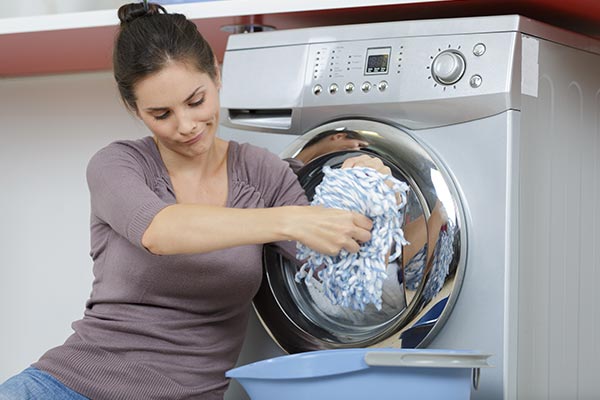
1.The first thing you will want to do is turn off the water. This will help prevent any further water damage to the already affected areas.
2. If you can safely do so, you should unplug the washer. Water and electricity do not mix. If you don’t think it’s safe, call the professionals at Rock Emergency (585) 413-1566.
3. Next, you’ll want to clean up any standing water. If the area is small enough to manage, you can remove the water using a mop/bucket, towels, or a wet-dry vacuum.
If the water is covering the entire floor (flooding water), it would be best to have the professionals at Rock Emergency come in to safely and effectively remove the water.
4. Once the standing water has been removed, you’ll want to have any wet or damaged items removed from the space.
Some items may not be salvageable if left in the water for too long. Photos, books, clothing, wooden furniture are among some items that can get ruined.
Regardless, it is best to get these items outside to begin the cleaning and drying out process. This also includes the clothes in the washer. If they are left in the washer, they will also be subject to mildew.
5. An assessment of the area can then be made to determine the extent of the washing machine water damage.
Extensive damage can be done to the floor or walls of the area. Drywall is a great source for mold to grow after it’s gotten wet.
The Rock Emergency professionals can assess and determine the possible level of damage from mold and mildew. It is usually best to have the wet drywall removed, and replaced to be sure there is no mold growth.
6. Before any restoration can begin, it is imperative to completely dry out the whole area. High-powered fans, dehumidifiers, and powerful water extraction mats can be used.
Rock Emergency has an array of water removal and drying equipment on hand, ready to be used at any time. The drying out process will also include any potentially salvageable items removed from the area.
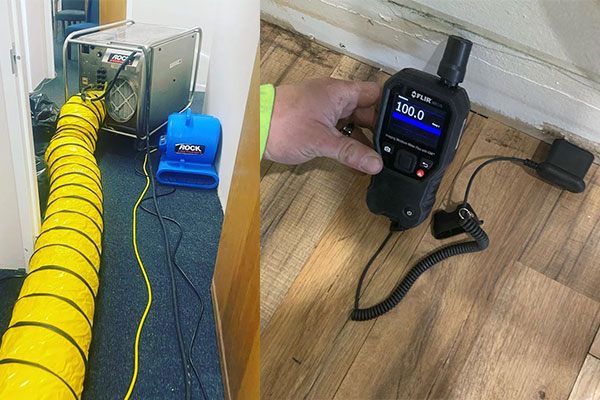
7. Once everything is dry, the restoration process can begin including patching walls and fixing floors. Depending on the severity of the damage, your salvageable items will also be restored. This includes document drying and restoration.
8. One of the final steps in the washing machine water damage restoration process is to disinfect and deodorize the area and the rest of the home.
Depending on how long it took to treat the area, there may be a musty odor left behind. Rock Emergency uses a variety of devices and products to help get the odors left behind from the water damage removed from the home.
9. Before using the washing machine, it would be recommended to have a small appliance technician come and assess possible damage to the machine.
Additionally, they would be able to repair the issues that caused the water damage to occur. It might even be best to purchase a new washer.
Restoration Services Provided by Rock Emergency
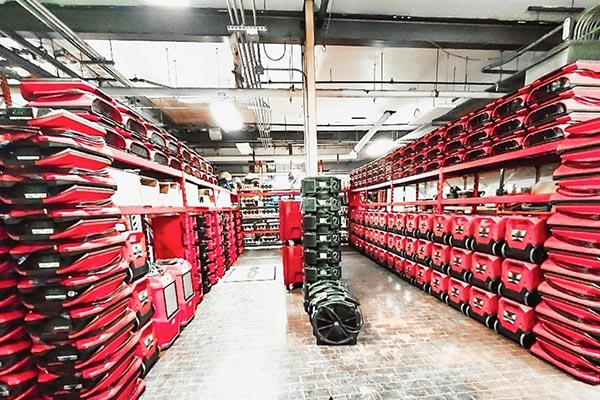
- Effective dry out of any space no matter how large or small
- Removal and Restoration of damaged materials (walls, flooring, ceilings)
- Cleaning and Restoration of household items
- Drying, cleaning, and restoration of documents
- Storage of removed items until restoration is complete.
- We’ll work with your insurance company on insurance claims, so you don’t have to!
Share this Post
